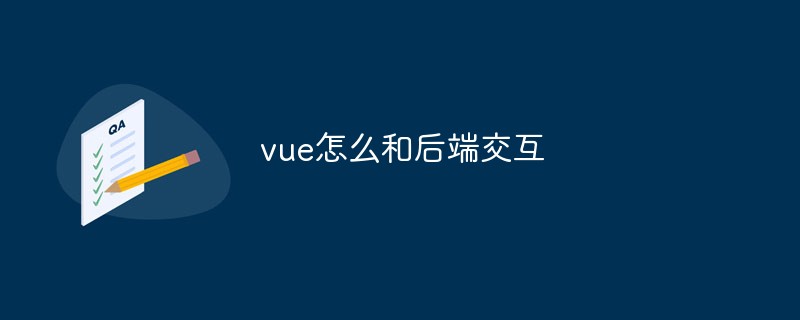
How to interact with vue and the backend: 1. Use the [$http.get()] method to realize interaction; 2. Use the [$http.post()] method to realize interaction; 3. Use [$http .jsonp()] method to achieve interaction.

Vue.js (pronounced /vjuː/, similar to view) is a progressive framework for building data-driven web interfaces. The goal of Vue.js is to enable responsive data binding and composed view components with the simplest possible API. Not only is it easy to get started, it is also easy to integrate with third-party libraries or existing projects.
How to realize the front-end and back-end interaction of vue.js?
1. Use the $http.get() method
to obtain an ordinary text data
this.$http.get('a.txt').then(function(res){
alert(res.data);
},function(res){
alert(res.status);
});Send data to the server (this You need to pass the second parameter {a:1, b:2} to the get method, which is the data to be sent)
this.$http.get('a.php', {
a: 1,
b: 2
}).then(function(res) {
alert(res.data);
}, function(res) {
alert(res.status);
});2. Use the $http.post() method
At this time, you need to pass the third parameter {emulateJSON: true} to the post method
this.$http.post('a.php', {
a: 1,
b: 2
}, {
emulateJSON: true
}).then(function(res) {
alert(res.data);
}, function(res) {
alert(res.status);
});3. Use the $http.jsonp() method
Visit 360 search interface
this.$http.jsonp('https://sug.so.360.cn/suggest', {
params: {
word: 'a'
}
}).then(function(res) {
alert(res.data.s);
}, function(res) {
alert(res.status);
});Visit baidu search interface
this.$http.jsonp('https://sp0.baidu.com/5a1Fazu8AA54nxGko9WTAnF6hhy/su', {
params: {
wd: 'a'
},
jsonp: 'cb'
}).then(function(res) {
alert(res.data.s);
}, function(res) {
alert(res.status);
});The above is the detailed content of How vue interacts with the backend. For more information, please follow other related articles on the PHP Chinese website!
 What to do if the installation system cannot find the hard disk
What to do if the installation system cannot find the hard disk
 Which brand does OnePlus mobile phone belong to?
Which brand does OnePlus mobile phone belong to?
 How to retain the number of decimal places in C++
How to retain the number of decimal places in C++
 mysql backup data method
mysql backup data method
 How to set up computer virtual memory
How to set up computer virtual memory
 Is wifi signal amplifier useful?
Is wifi signal amplifier useful?
 Three ways to end a thread in java
Three ways to end a thread in java
 What are the data types?
What are the data types?